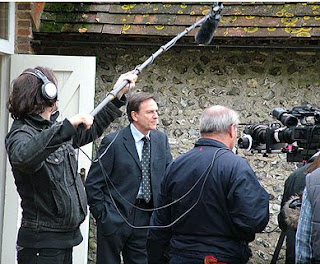 By Dan Parkes (Director)
By Dan Parkes (Director)One of the first victims of low-budget film production is unfortunately often the sound. Even higher end productions can have sound issues, so it is no wonder that when the budget is low or non-existant that the sound suffers first. However, when good visuals are marred by poor or unprofessional sound the result can be very detrimental to the entire project. And since good sound is not rocket science or hugely expensive, there should be no need for it to ever suffer.
On Ambleton Delight we had a very simple set up that in the end was very effective -in fact many have commented on how good the sound is. Firstly we had a great sound man, Colin Bradley, with a good ear for sound. Technically we used a Sennheiser ME-66 shot gun microphone with a K6 power supply, a Rycote Softie with pistol grip/suspension and a Lightwave G5 carbon fibre boom pole. This is not particularly expensive kit and is affordable whether purchased or hired.
Ideally it is better to record the sound into a DAT or some other kind of separate audio recorder, and use a clapperboard and then sync later in post (this is especially true with the present sound limitations of DSLRS). However we ended up recording the sound direct to camera via an XLR lead. While not ideal this has the benefit of having the sound already synced for post. The negative was that our sound recordist had to monitor the sound via the camera which meant he was not free to move far from the camera's position.
Some key points to remember:
- Use separate microphones. Do not ever use the stock camera microphone as it is almost always poor quality and picks up camera noise.
- Use directional mics. Shot gun mics or lapel/radio mics are best, depending on the environment and acoustics.
- Be sound conscious. Bad sound equals bad film. When planning a shoot think about possible sound interefence issues.
- Have sound monitered by someone with a good ear, using headphones. You might not notice that plane flying overhead, but a good recordist will. They will also know how best to use the microphones and what levels are good.
- Record room tones and extra bacground sound whenever possible. For example, we recorded people talking and clapping in the village hall for later reference and proved invaluable.
- Don't ever say 'fix it in post'! While good sound post-production is a must, try to get the best you can on the shoot as ADR and other post fix-it measures are not always satisfactory.







No comments:
Post a Comment